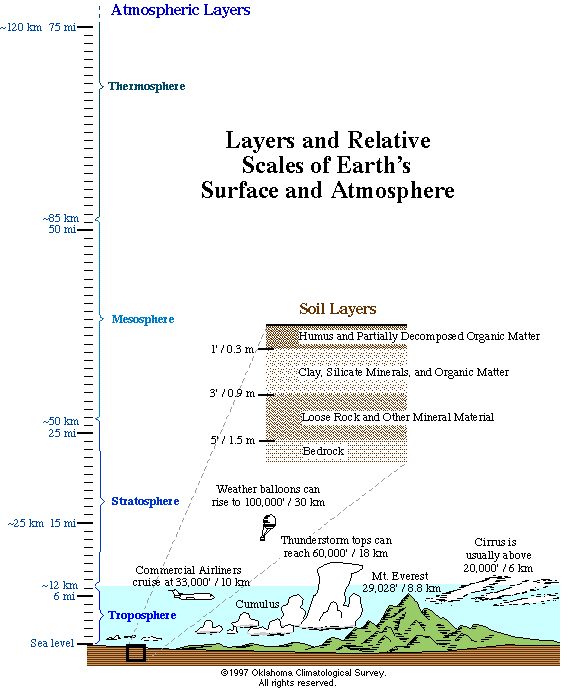|
|
Vertical Structure of the Atmosphere
Part 1
|
|
|
|
|
|
|
Principle
|
The changes in the atmosphere with height
are results of specific physical conditions which exist on
the earth and in its atmosphere. The vertical changes in
temperature are important in constraining weather events to
the lowest 10-12 km of the atmosphere. The ozone layer,
located near 25 km above the earth's surface, causes the
temperature to rapidly change in the middle
atmosphere.
|
|
|
|
|
|
|
Figure 1 - Layers of Earth's Atmosphere
|
|
|

|
|
|
Troposphere
(~10 deg to -60 deg C)
|
- From the earth's surface to 11-12 km above,
temperature decreases with height.
This fact results from the sun's
radiation striking the earth and the earth then warming
the air above it. So the closer the air is to the ground,
the warmer it becomes. The rate of change of air
temperature with height is called the "lapse rate". In
the troposphere, the lapse rate is generally about 6.5
deg C per kilometer increase in altitude.
- The temperature can increase with height in
the lower troposphere.
When this happens, it is called
an "inversion". If the temperature remains the same with
height, it is called "isothermal".
- The actual lapse rate varies with location, time of
day, weather conditions, season, etc.
- Because warm air tends to rise and cool air tends to
sink, the troposphere is a location of much movement of
air, or "turbulence".
Hence, the troposphere is
described by meteorologists as being "well-mixed". If
pollutants are injected into the troposphere, they are
mixed throughout its depth in a few days and, usually
within a week or so, will fall back to the ground with
the rain (e.g., acid rain). Thus, the troposphere has a
self-cleaning mechanism.
|
|
|
|
|
|
|
Stratosphere
(~0 deg to -60 deg C)
|
- The stratosphere is marked by a
temperature inversion from about 11-12 km to 50 km above
sea level.
Because warmer air lies above
cooler air in this region, there are few overturning air
currents and, thus, the stratosphere is a region of
little mixing. Particles that travel from the troposphere
into the stratosphere can stay aloft for many years
without returning to the ground. For example, large
volcanic eruptions force ash to be projected into the
stratosphere, where it may remain for years and causing
slight global cooling in the process.
- It is relatively easy to see
where the stratosphere begins when there are large
convective storms around.
The tops of these storms reach
only into the lowest level of the stratosphere. Because
of the temperature inversion, air rising in the
thunderstorm eventually becomes cooler than its
environment in the stratosphere and stops rising.
- Why does the temperature
increase with height in the stratosphere?
Because the ozone
(O3) layer mostly resides at this level in
the atmosphere. Ozone absorbs UV radiation from the sun
which, in turn, increases the motion of the ozone
molecules. The ozone molecules then collide with other
molecules in the air, increasing its temperature.
- The importance of the ozone
layer lies in the facts that (1) ozone helps the earth to
maintain its heat balance, and (2) ozone reduces the
amount of harmful UV radiation that reaches the earth's
surface.
Ozone is both produced and
destroyed in the stratosphere. Ozone destruction can be
both natural (UV radiation or molecular collisions) or
man-made (e.g., chlorofluorocarbons).
|
|
|
|
|
|
|
Mesosphere
(0 deg to -90 deg C)
|
- The mesosphere resides from
about 50 km to 80-90 km above the earth's surface.
- Because 99.9% of the mass of
the atmosphere lies below the stratopause, the air
pressure and density in the mesosphere are extremely low
(about 1/1000th of the surface).
- There is not enough oxygen to
breathe here, although the percentage of oxygen in the
atmosphere is about the same.
|
|
|
|
|
|
|
Thermosphere
(500-1500 deg to -90 deg C)
|
- The thermosphere lies above about 90 km. Oxygen
absorbs UV radiation and gains significant kinetic energy
(i.e., few molecules are around to bump into).
- Unlike in the troposphere and stratosphere,
temperatures in the thermosphere can change by hundreds
of degrees depending on the amount of solar activity.
|
|
|
|
|
|
|
|

|
